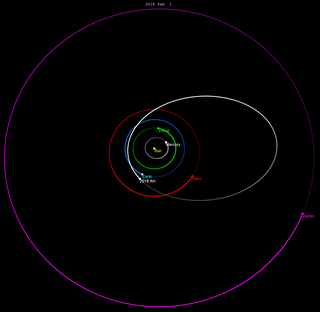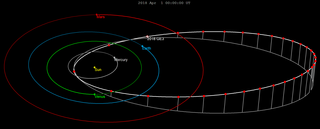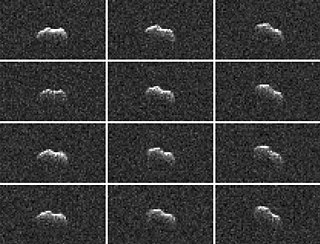2012 KT42 is an Apollo near-Earth asteroid first observed by astronomer Alex R. Gibbs of the Mount Lemmon Survey with a 1.5-meter reflecting telescope on 28 May 2012.

2014 HQ124 is a sub-kilometer asteroid, classified as near-Earth object and potentially hazardous asteroid of the Aten group, approximately 400 meters (1,300 feet) in diameter. It passed 3.25 lunar distances (LD) from Earth on 8 June 2014. It was discovered on 23 April 2014 by NEOWISE. It is estimated that an impact event would have had the energy equivalent of 2,000 megatons of TNT and would have created a 5 km (3 mi) impact crater. The news media misleadingly nicknamed it The Beast. 2014 HQ124 previously passed this close to Earth in 1952 and will not again until at least 2307. Radar imaging suggests it may be a contact binary.
2014 XL7 is a near-Earth object and Apollo asteroid, approximately 230 meters (750 feet) in diameter. It was the most dangerous potentially hazardous asteroid on Sentry Risk Table upon its discovery by the Mount Lemmon Survey in December 2014. At the time, the asteroid had a cumulative 1 in 83000 chance of impacting Earth on 4–5 June between the years 2048 and 2084. After the object's observation arc had been extended to 35 days, it was removed from the Sentry Risk Table on 15 January 2015. Since then the asteroid's orbit has been secured. Although it has an Earth minimum orbit intersection distance of less than one lunar distance, there are no projected close encounters with Earth in the foreseeable future, with its closest passage to occur in May 2046, still millions of kilometers away.
(456938) 2007 YV56, provisional designation 2007 YV56, is a sub-kilometer asteroid on an eccentric orbit, classified as a near-Earth object and potentially hazardous asteroid of the Apollo group, approximately 190–360 meters (620–1,200 ft) in diameter. It was discovered on 31 December 2007, by astronomers of the Catalina Sky Survey conducted at the Catalina Station in Arizona, United States.
2013 TX68 is an Apollo asteroid and near-Earth object discovered on 6 October 2013 by the Catalina Sky Survey, during which it was near a close approach of 5.4 Lunar distances (LD) from the Earth. The asteroid only has a 10-day observation arc which makes long-term predictions of its position less certain. It was observed for three days as it approached Earth in the night sky starting with the sixth of October, 2013. Then it became unobservable by being between the Earth and the Sun, then not recovered due to its small size and dimness. Precovery images by Pan-STARRS from 29 September 2013 were announced on 11 February 2016 that extended the observation arc to 10 days. It was removed from the Sentry Risk Table on 11 February 2016, so there is no risk of impact from this object for the next hundred years or more. The asteroid was last observed on 9 October 2013.
2017 TD6 is a micro-asteroid, classified as a near-Earth object of the Apollo group, approximately 10–20 meters in diameter. It was first observed by Pan-STARRS at Haleakala Observatory, Hawaii, on 11 October 2017.

2017 OO1 is a small asteroid, classified as near-Earth object of the Aten group, approximately 35–76 meters (115–249 feet) in diameter. It was first observed on 23 July 2017, by the robotic ATLAS survey at Mauna Loa Observatory, Hawaii, two days after the object had approached Earth at 0.33 lunar distances on 21 July 2017.

2017 XO2, also written 2017 XO2, is a sub-kilometer asteroid and near-Earth object of the Apollo group approximately 110 meters (360 feet) in diameter. The asteroid was discovered by Pan-STARRS in December 2017, after it already had approached Earth at 0.051 AU (7,600,000 km) or 20 lunar distances (LD) on 6 November 2017. On 26 April 2057, it will pass Earth at a similar distance of 21 LD again.

2018 AH is a sub-kilometer asteroid, classified as near-Earth object of the Apollo group, approximately 100 m (300 ft) in diameter. It was first observed on 4 January 2018, by the Asteroid Terrestrial-impact Last Alert System (ATLAS) on Mauna Loa and quickly followed-up by many other surveys, with precovery observations found from Pan-STARRS and PTF from the day previous.

2018 CN2 is a very small asteroid, classified as a near-Earth object of the Apollo group, approximately 5 to 16 meters in diameter. It was first observed by astronomers of the Mount Lemmon Survey at Mount Lemmon Observatory, Arizona, on 8 February 2018, one day prior its close encounter with Earth at 0.18 lunar distances.

2018 CF2 is a micro-asteroid and near-Earth object of the Apollo group on an eccentric orbit with has an estimated 4–15 meters (10–50 ft). It was first observed on 7 February 2018, by astronomers of the Mount Lemmon Survey at Mount Lemmon Observatory, Arizona, United States. The discovery occurred the day after its sub-lunar passage as it approached the Earth from a sunward direction, and this flyby altered the asteroid's orbit slightly.

2018 GE3 is a sub-kilometer asteroid on a highly eccentric orbit, classified as a near-Earth object of the Apollo group, approximately 48–110 meters (160–360 feet) in diameter. It was first observed on 14 April 2018, by astronomers with the Catalina Sky Survey one day prior to its sub-lunar close encounter with Earth at 0.5 lunar distance. It is one of the largest known asteroids (possibly the largest) in observational history to ever pass that close to Earth (also see list).
2011 ES4 (also written 2011 ES4) is an Apollo near-Earth asteroid roughly 22–49 meters (72–160 feet) in diameter. It was first observed on 2 March 2011 when the asteroid was about 0.054 AU (8,100,000 km; 5,000,000 mi) from Earth and had a solar elongation of 159 degrees. It passed closest approach to Earth on 13 March 2011. Before the 2020 approach, the asteroid had a short observation arc of 4 days and had not been observed since March 2011. The asteroid was expected to pass within 1 lunar distance of Earth in early September 2020, but did not. There was no risk of a 2020 impact because the line of variation (LOV) did not pass through where Earth would be, and the closest possible 2020 Earth approach was about 0.00047 AU (70,000 km; 44,000 mi). One line of variation showed the asteroid passing closest to Earth on 5 September 2020 at 0.06 AU (9,000,000 km; 5,600,000 mi) with a magnitude of 23, which would place it near the limiting magnitude of even the best automated astronomical surveys.

2019 MO, temporarily designated A10eoM1, was a small, harmless 3-meter near-Earth asteroid discovered by ATLAS–MLO that impacted Earth's atmosphere on 22 June 2019 at 21:25 UT. The impact of the bolide generated a 5-kiloton-equivalent explosion off the south coast of Puerto Rico which was detected by infrasound detectors. The strewn field would be spread over the Caribbean Sea.
2018 VP1 is an Apollo near-Earth asteroid roughly 2 meters (7 feet) in diameter. The asteroid had a 0.41% chance (1 in 240) of impacting Earth on 2 November 2020 01:12 UT. It was discovered on 3 November 2018 when it was about 0.003 AU (450,000 km; 280,000 mi) from Earth and had a solar elongation of 165 degrees. The asteroid has a short 12.9 day observation arc. It was last observed on 16 November 2018 by the European Southern Observatory Very Large Telescope at apparent magnitude 26 pushing the telescope close to the limiting magnitude.

2020 LD is an Apollo near-Earth asteroid roughly 140 meters in diameter. It was discovered on 7 June 2020 when the asteroid was about 0.03 AU from Earth and had a solar elongation of 154 degrees. The glare of the Sun had masked the approach of the asteroid since November 2019. The asteroid passed closest approach to Earth on 5 June 2020 at a distance of 0.002 AU. The close approach distance is now known with an accuracy of roughly ± 1000 km. This is the largest asteroid to pass closer than the Moon this year and possibly the largest since (308635) 2005 YU55 in November 2011. The asteroid makes close approaches to Mercury, Venus, Earth, and Mars. It will be brighter than apparent magnitude 24 until 18 July 2020.
2017 QC36 is a near-Earth object and a potentially hazardous asteroid of the Aten group, It measures approximately 200 meters (660 feet) in diameter and was briefly observed by the Wide-field Infrared Survey Explorer on 18 August 2017 before it became a lost asteroid on the following day. It was later recovered in 2021 from archival Pan-STARRS and Cerro Tololo observations.

(231937) 2001 FO32 is a near-Earth asteroid classified as a potentially hazardous asteroid of the Apollo group. With an estimated diameter around 550 m (1,800 ft), it was discovered by the Lincoln Near-Earth Asteroid Research at Socorro, New Mexico on 23 March 2001. The asteroid safely passed by Earth on 21 March 2021 16:03 UTC from a closest approach distance of 0.0135 AU (2.02 million km; 1.25 million mi), or 5.25 lunar distances (LD). During the day before closest approach, 2001 FO32 reached a peak apparent magnitude of 11.7 and was visible to ground-based observers with telescope apertures of at least 20 cm (8 in). It is the largest and one of the fastest asteroids to approach Earth within 10 LD (3.8 million km; 2.4 million mi) in 2021.

(620094) 2016 AJ193 (provisional designation 2016 AJ193; also known as 2010 KV134) is a near-Earth object and potentially hazardous asteroid of the Apollo group, approximately 1.4 kilometres (0.87 mi) in diameter. It was discovered on 17 May 2010 by the Wide-field Infrared Survey Explorer (WISE) satellite, but was lost until it was reobserved on 16 January 2016. With an observation arc over 11 years, 2016 AJ193 has a well-determined orbit and trajectory through the year 2086. The asteroid's orbit is only potentially hazardous on a time scale of thousands of years.

















